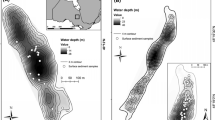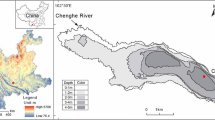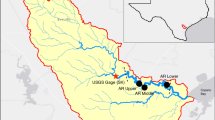Abstract
The influence of episodic, sediment resuspension on phytoplankton abundance/volume and composition, the photosynthetic maximum rate (PB max) and efficiency (αB), and chlorophyll-specific growth (μChl) was evaluated during the spring isothermal period in southern Lake Michigan (Laurentian Great Lakes, USA). Resuspension altered the nutrient and light climate of nearshore waters; light attenuation (Kd) and phosphorus concentrations corresponded (p ≤ 0.0001 and p ≤ 0.001, respectively) with concentrations of suspended particulate matter (SPM). Phytoplankton cell volume and diatom cell abundance and volume were not associated with SPM concentrations (p > 0.05). Diatom composition displayed spatial dissimilarities corresponding with resuspension (p ≤ 0.001); small centric diatoms exhibiting meroplanktonic life histories and pennate diatoms considered benthic in origin were most abundant within SPM-impacted, nearshore waters whereas taxa typically comprising assemblages in optically-clear, offshore waters and the basin-wide, spring bloom were not. Values of PB max and αB corresponded (p ≤ 0.0001) with both Kd coefficients and SPM concentrations, potentially reflecting increased light harvesting/utilization within impacted assemblages. However, integral production was inversely associated with Kd coefficients and SPM concentrations (p < 0.0001) and photosynthesis was light-limited (or nearly so) for most assemblages. Although μChl values corresponded with Kd coefficients (p ≤ 0.05), values were quite low (x ± S.E., 0.10 ± 0.004 d-1) throughout the study. Most likely, distinct rate processes between SPM- and non-impacted assemblages reflected short-term compositional (and corresponding physiological) variations due to infusion of meroplankton and/or tributary-derived phytoplankton. Overall, resuspension appears to have little, if any, long-term impact upon the structure and function of the lake’s phytoplankton.
Similar content being viewed by others
References
Barbiero R.P., Carrick H.J., Volerman J.B., and Tuchman M.L. 2000. Factors affecting temporal and spatial distribution of diatoms in Lake Michigan. Verh. Internat. Verein. Limnol. 27: 1788–1794.
Beaver J. 1981. Apparent ecological characteristics of some common freshwater diatoms. Ontario Ministry of the Environment (517 pp.). Don Mills, Ontario, Canada.
Bergman T., Fahnenstiel G.L., Lohrenz S.E., Millie D.F. and Schofield O.M.E. 2002–in press. The impacts of a recurrent resuspension event and variable phytoplankton community composition on remote sensing reflectance. J. Geophys. Res.
Biddanda B.A. and Cotner J.B. 2002. Love handles in aquatic ecosystems: the role of dissolved organic carbon drawdown, resuspended sediments, and terrigenous inputs in the carbon balance of Lake Michigan. Ecosystems 5: 431–445.
Brooks A.S. and Eddington D.N. 1994. Biogeochemical control of phosphorus cycling and primary production in Lake Michigan. Limnol. Oceanogr. 39: 961–967.
Brooks A.S. and Torke B.G. 1977. Vertical and seasonal distribution of Chl a in Lake Michigan. J. Fish. Res. Board Can. 34: 2280–2287.
Carrick H.J., Aldridge F.J. and Schelske C.L. 1993. Wind influences phytoplankton biomass and composition in a shallow, productive lake. Limnol. Oceanogr. 38: 1179–1192.
Chang W.Y.B. and Rossmann R. 1988. Changes in the abundance of blue-green algae related to nutrient loadings in the nearshore of Lake Michigan. Hydrobiologia 157: 271–278.
Clarke K.R. and Warwick R.M. 2001. Change in marine communities: an approach to statistical analyses and interpretation, 2nd ed. Primer-E, Plymouth, UK.
Clarke K.R. and Gorley R.N. 2001. PRIMER v5: User Manual/Tutorial. Primer-E, Plymouth, UK.
Claustre H., Kerherv P., Marty J.C., Prieur L., Videau C. and Hecq J.-H. 1994. Phytoplankton dynamics associated with a geostrophic front: ecological and biogeochemical implications. J. Mar. Res. 52: 711–742.
Cloern J.E. 1987. Turbidity as a control on phytoplankton biomass and productivity in estuaries. Cont. Shelf. Res. 7: 1367–1381.
Conley D.J., Quigley M.A. and Schelske C.L. 1988. Silica and phosphorus flux from sediments: importance of internal recycling in Lake Michigan. Can. J. Fish. Aquat. Sci. 45: 1030–1035.
Cotner J.B., Johengen T.H. and Biddanda B. 2000. Intense winter heterotrophic production stimulated by benthic resuspension. Limnol Oceanogr 45: 1672–1676.
Cullen J.J. 2002. Phytoplankton productivity. J. Phycol. 38: 1273–1275.
Davis C.O. and Simmons M.S. 1979. Water Chemistry and Phytoplankton Field and Laboratory Procedures, Great Lakes Research Division Special Report No. 70. University of Michigan, Ann Arbor, Michigan, USA.
Demers S., Therriault J.-C., Bourget E. and Desilets H. 1989. Small-scale gradients of phytoplankton productivity in the littoral fringe. Mar. Biol. 100: 393–399.
Dunstan W.M. 1973. A comparison of the photosynthesis-light intensity relationship in phylogenetically-different microalgae. J. Exp. Mar. Biol. Ecol. 13: 181–187.
Eadie B.J., Chambers R.L., Gardner W.S. and Bell G.L. 1984. Sediment trap studies in Lake Michigan: resuspension and chemical fluxes in the southern basin. J. Great Lakes Res. 10: 307–321.
Eadie B.J., Schwab D.J., Johengen T.H., Lavrentyev P.J., Miller G.S., Holland R.E., Leshkevich G.A., Lansing M.B., Morehead N.R., Robbins J.A., Hawley N., Edgington D.N. and Van Hoof P.L. 2002. Particle transport, nutrient cycling, and algal community structure associated with a major winter-spring sediment resuspension event in southern Lake Michigan. J. Great Lakes Res. 28: 324–337.
Eadie B., Schwab D., Assel R., Hawley N., Lansing B., Miller R., Morehead N. and Robbins J. 1996. Development of recurrent coastal plume in Lake Michigan observed for the first time. EOS Trans Am. Geophys. Union 77: 337–338.
Epply R.W. 1972. Temperature and phytoplankton growth in the sea. Fish. Bull. S. 70: 1063–1085.
Fahnenstiel G.L. and Scavia D. 1987a. Dynamics of Lake Michigan phytoplankton: primary production and growth. Can. J. Fish. Aquat. Sci. 44: 499–508.
Fahnenstiel G.L. and Scavia D. 1987b. Dynamics of Lake Michigan phytoplankton: recent changes in surface and deep communities. Can. J. Fish. Aquat. Sci. 44: 509–514.
Fahnenstiel G.L., Scavia D. and Schelske C.L. 1984. Nutrient-light interactions in the Lake Michigan subsurface Chl layer. Verh. Internat. Verein. Limnol. 22: 440–444.
Fahnenstiel G.L., Chandler J.F., Carrick H.J. and Scavia D. 1989. Photosynthetic characteristics of phytoplankton communities in Lakes Huron and Michigan: P-I parameters and end-products. J. Great Lakes Res. 15: 394–407.
Fahnenstiel G.L. Krause A.E., McCormick M.J., Carrick H.J. and Schelske C.L. 1998. The structure of the planktonic food-web in the St. Lawrence Great Lakes. J. Great Lakes Res. 24: 531–544.
Fahnenstiel G.L., McCormick M.J., Lang G.A., Redalge D.G., Lohrenz S.E., Markowitz M., Wagoner B. and Carrick H.J. 1995b. Taxon-specific growth and loss rates for dominant phytoplankton populations from the northern Gulf of Mexico. Mar. Ecol. Prog. Ser. 117: 229–239.
Fahnenstiel G.L., Stone R.A., McCormick M.J., Schelske C.L. and Lohrenz S.E. 2000. Spring isothermal mixing in the Great Lakes: evidence of nutrient limitation and nutrient-light interactions in a suboptimal light environment. Can. J. Fish. Aquat. Sci. 57: 1901–1910.
Fahnenstiel G.L., Beckmann C., Lohrenz S.E., Millie D.F., Schofield O.M.E. and McCormick M.J.M. 2002. Standard Niskin and Van Dorn bottles inhibit phytoplankton photosynthesis in Lake Michigan. Verh. Internat. Verein. Limnol. 28: 376–380.
Fahnenstiel G.L., Bridgeman T.B., Lang G.A., McCormick M.J. and Nalepa T.F. 1995a. Phytoplankton productivity in Saginaw Bay, Lake Huron: effects of zebra mussels (Dreissena polymorpha) colonization. J. Great Lakes Res. 21: 465–475.
Fitzgerald S.A. and Gardner W.S. 1993. An algal carbon budget for pelagic/benthic coupling. Limnol. Oceanogr. 38: 547–560.
Fogg G.E. 1991. The phytoplanktonic ways of life. New Phytol. 118: 191–232.
Gardner W.S., Quigley M.A., Fahnenstiel G.L., Scavia D. and Frez W.A. 1990. Pontoporeia hoyi - a direct trophic link between spring diatoms and fish in Lake Michigan. In: Tilzer M.M. and Serruya C. (eds), Large Lakes Ecological Structure and Function. Springer-Verlag, New York, New York, USA, pp. 632–644.
Geider R.J., Platt T. and Raven J.A. 1986. Size dependence of growth and photosynthesis in diatoms: a synthesis. Mar. Ecol. Prog. Ser. 30: 93–104.
Harris G.P. 1973. Diel and annual cycles of net plankton photosynthesis in Lake Ontario. J. Fish. Res. Board Can. 30: 1179–1187.
Hartig J.H. 1987. Factors contributing to the development of Fragilaria crotonensis Kitton pulses in Pigeon Bay waters of western Lake Erie. J. Great Lakes Res. 13: 65–77.
Imai I., Itakura S., Yamaguchi M. and Honjo T. 1996. Selective germination of Heterosigma akashiwo (Raphidophyceae) cysts in bottom sediments under low light conditions: a possible mechanism of red tide initiation. In: Yasumoto T., Oshima Y. and Fukuyo Y. (eds), Harmful and Toxic Algal Blooms Intergovern Oceanogr. Comm UNESCO, Paris, France, pp. 197–200.
Imai I. and Itakura S. 1999. Importance of cysts in the population dynamics of the red tide flagellate Heterosigma akashiwo. Mar. Biol. 133: 755–762.
Itakura S., Nagasaki K., Yamaguchi M. and Imai I. 1996. Species succession between Skeletonema costatum and Heterosigma akashiwo in Hiroshima Bay, Japan, with special reference to the resting stage cells in the bottom sediments. In: Yasumoto T., Oshima Y. and Fukuyo Y. (eds), Harmful and Toxic Algal Blooms, pp. 373–376. Intergovern Oceanogr. Comm. UNESCO, Paris, France.
Kelly K.A. 2001. The effects of a recurrent coastal plume on the absorption characteristics of phytoplankton species in Lake Michigan. M. Sci. Thesis, The University of Southern Mississippi, Hattiesburg, USA.
Klarer D.M. and Millie D.F. 1989. Amelioration of storm-water quality by a freshwater estuary. Arch für Hydrobiol 116: 375–389.
Klarer D.M. and Millie D.F. 1994. Regulation of phytoplankton dynamics in a Laurentian Great lakes estuary. Hydrobiologia 286: 97–108.
Ladewski T.B. and Stoermer E.F. 1973. Water transparency in southern Lake Michigan in 1971 and 1972. In Proc 16th Conf. Great Lakes Res., pp. 791–807. Internat. Assoc. Great Lakes Res.
Lang G.A. and Fahnenstiel G.L. 1996. Great Lakes primary production model - methodology and use, Technical Memorandum ERL GLERL-90. NOAA, US Dept. Comm., Ann Arbor, Michigan, USA.
Lohrenz S.E., Wiesenburg D.A., De Palma I.P., Johnson K.S. and Gustafson D.E. 1988. Interrelationships among primary production, Chl, and environmental conditions in frontal regions of the western Mediterranean Sea. Deep-Sea Res. 35: 793 - 810.
Lund J.W.G. 1954. The seasonal cycle of the plankton diatom, Melosira italica (Her.) subsp. subarctica O. Mull. J. Ecol. 42: 151–179.
Makarewicz J.C., Baybutt R.I. and Damann K. 1979. Changes in the apparent temperature optima of the plankton of Lake Michigan at Chicago, Illinois. J. Fish. Res. Board Can. 36: 1169–1173.
Menzel D.W. and Corwin N. 1965. The measurement of total phosphorus liberated in seawater based on the liberation of organically bound fractions by persulfate oxidation. Limnol. Oceanogr. 10: 280–281.
Millie D.F., Fahnenstiel G.L., Carrick H.J., Lohrenz S.E. and Schofield O.M.E. 2002a. Phytoplankton pigments in coastal Lake Michigan: distributions during the spring isothermal period and relation with episodic sediment resuspension. J. Phycol. 38: 639–648.
Millie D.F., Fahnenstiel G.L., Carrick H.J., Lohrenz S.E. and Schofield O.M.E. 2002b. Spatial variation in Lake Michigan phytoplankton composition during sediment resuspension events. Verh. Internat. Verein. Limnol. 28: 1216–1220.
Mortimer C.H. 1988. Discoveries and testable hypotheses arising from the Coastal Zone Color Scanner imagery of southern Lake Michigan. Limnol. Oceanogr. 33: 203–226.
O’Donohue M.J. and Dennison W.C. 1997. Phytoplankton productivity response to nutrient concentration, light availability and temperature along an Australian estuarine gradient. Estuaries 20: 521–33.
Roy S., Chanut J.-P., Gosselin M. and Sime-Ngando T. 1996. Characterization of phytoplankton communities in the lower St. Lawrence Estuary using HPLC-detected pigments and cell microscopy. Mar. Ecol. Prog. Ser. 142: 55–73.
Scavia D. and Fahnenstiel G.L. 1987. Dynamics of Lake Michigan phytoplankton: mechanisms controlling epilimnetic communities. J. Great Lakes Res. 13: 103–120.
Schelske C.L., Feldt L.E., Simmnos M.S. and Stoermer E.F. 1974. Storm induced relationships among chemical conditions and phytoplankton in Saginaw Bay and western Lake Huron. In: Proc 17th Conf. Great Lakes Res. pp. 78–91. Internat. Assoc. Great Lakes Res.
Schelske C.L., Stoermer E.F., Fahnenstiel G.L. and Haibach M. 1986. Phosphorus enrichment, silica utilization, and biogeochemical silica depletion in the Great Lakes. Can. J. Fish. Aquat. Sci. 43: 407–415.
Schelske C.L., Carrick H.J. and Aldridge F.J. 1995. Can wind-induced resuspension of meroplankton affect phytoplankton dynamics? J. N. Am. Benthol Soc. 14: 616–630.
Schelske C.L., Davis C.O. and Feldt L.E. 1984. Growth responses of river and lake phytoplankton populations in Lake Michigan water. Verh. Internat. Verein. Limnol. 22: 445–451.
Schwab D.J., Beletsky D. and Lou J. 2000. The 1998 coastal turbidity plume in Lake Michigan. Estuar. Coast Shelf. Sci. 50: 49–58.
Sicko-Goad L., Stoermer E.F. and Fahnenstiel G.L. 1986. Rejuvenation of Melosira granulata (Bacillariophyceae) resting cells from the anoxic sediments of Douglas Lake, Michigan. I. Light microscopy and 14C uptake. J. Phycol. 22: 22–28.
Sicko-Goad L., Stoermer E.F. and Kociolek J.P. 1989. Diatom resting cell rejuvenation and formation: time course, species records and distribution. J. Plankton Res. 11: 375–389.
Smetacek V.S. 1985. Role of sinking in diatom life-history cycles: Ecological, evolutionary, and geological significance. Mar. Biol. 84: 239–251.
Stoermer E. 1968. Nearshore phytoplankton populations in the Grand Haven, Michigan vicinity during thermal bar conditions. In: Proc 11th Conf. Great Lakes Res. Internat. Assoc. Great Lakes Res., pp. 137–150.
Stoermer E.F. and Ladewski T.B. 1976. Apparent optimal temperatures for the occurrence of some common phytoplankton species in southern Lake Michigan, Great Lakes Res Div. Pub. 18. University of Michigan, Ann Arbor, Michigan, USA.
Tester P.A., Geesey M.R., Guo C., Paerl H.W. and Millie D.F. 1995. Evaluating phytoplankton dynamics in the Newport River Estuary (North Carolina, USA.) by HPLC-derived pigment profiles. Mar. Ecol. Prog. Ser. 124: 237–45.
US Environmental Protection Agency and Government of Canada 1995. The Great Lakes: An Environmental Atlas and Resource Book. 3rd ed. Environment Canada, Toronto, Canada.
Utermohl H. 1958. Zur Vervolkommung der quantitativen phytoplankton. Mitt. Int. Verein. Limnol. 9: 1–13.
Vollenweider R.A. 1974. A manual on methods for measuring primary production in aquatic environments, 2nd ed. IBP Handbook No. 12. Blackwell Scientific, Oxford, UK.
Wetzel R.G. 2001. Limnology: Lake and River Ecosystems, 3rd ed. Academic Press, San Diego, California, USA.
Author information
Authors and Affiliations
Corresponding author
Rights and permissions
About this article
Cite this article
Millie, D.F., Fahnenstiel, G.L., Lohrenz, S.E. et al. Physical-Biological Coupling in Southern Lake Michigan: Influence of Episodic Sediment Resuspension on Phytoplankton. Aquatic Ecology 37, 393–408 (2003). https://doi.org/10.1023/B:AECO.0000007046.48955.70
Issue Date:
DOI: https://doi.org/10.1023/B:AECO.0000007046.48955.70




